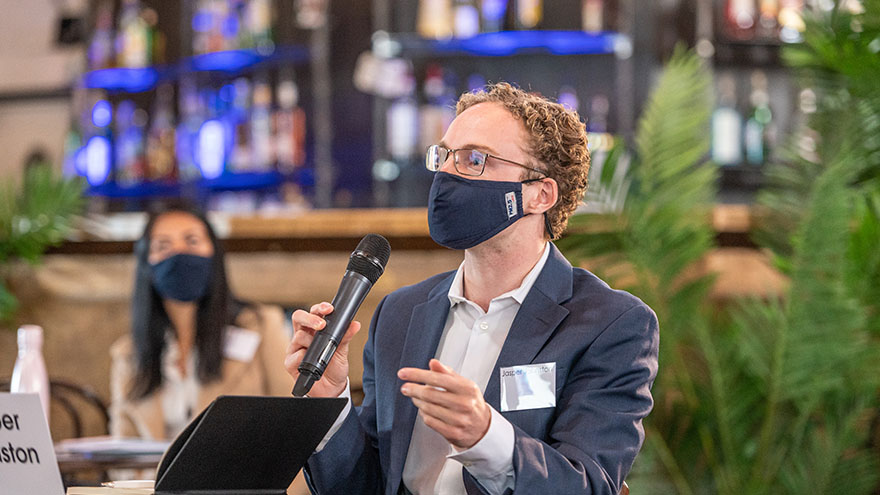Building and maintaining an effective team, from classroom to boardroom

The question of how to build and sustain an effective team is regularly top-of-mind for leaders around the world, whether in boardrooms or in cabinets. It is also something that students will be familiar with — in particular, MPP students are encouraged to form study groups, teams of 5-8 people who collaborate to cover key readings and discuss course material, to help navigate the course’s rigorous academic schedule.

Forming a study group is one thing, but building and sustaining an effective, cohesive group is another and this year, the COVID-19 pandemic added another twist to this process, impacting where and whether people can meet in person, and even what time zones they may be in.
At the start of Michaelmas term, as we dove into classes, different approaches to forming groups emerged. Some people latched onto the first classmates they found who shared common interests. Some were more reserved, waiting to develop deeper relationships and see how the term unfolded. Others partook in a student-led initiative three-weeks into the term that aggregated those still interested in joining a group. No approach is best and each student experienced different obstacles.
Through conversations with classmates and personal experience, I have compiled a list of ten strategies to consider in building (and maintaining) an effective team, whether it’s a study group, a project team, or a cabinet.
Ten strategies for effective teams
Select team members carefully and prioritise diversity
It is easy to gravitate towards those who are similar to us, but diverse groups will achieve better results and ultimately go further. Diversities of culture, experience, country of origin, age, gender identity, personality types, and more can provide unique lenses that shape ideas in new and unexpected ways, generating collective value. Furthermore, where possible, aim to keep team numbers small—5-7 people is often ideal, particularly if the objective is to ensure active participation by all members.
Getting started is the often the most difficult step
Regardless of experience, it can always be challenging to start working with new people. Take the leap! Reach out, schedule a first meeting time, and use this time to get to know one another, discuss interests and expectations, and set out a plan for regular meetings/collaboration. The first few meetings may be bumpy as you navigate each other’s working styles, but you should fall into a rhythm after a few meetings.
Meet online
Given lockdowns, social distancing restrictions, and many people working remotely, meeting online is currently the most effective and inclusive method for meetings. As beneficial as in-person meetings can be, even having a few people from the team together in-person and a few people joining online can create awkward dynamics (both socially and technically!) that undermine a group’s cohesion and effectiveness. Even in non-pandemic times, meeting online may be optimal as it reduces travel time and meets people where they are at, allowing them to have all the space they need for their notes and documents, letting them be in the space where they feel most comfortable, and reducing distractions that may arise from meeting in person.
Develop group norms early
Getting on the same page from the start about expectations, interests, and approaches to navigating disagreements is foundational to long-term success—or, at the very least, can save significant time and energy down the road. Some things that may be helpful to integrate into this discussion include norms around confidentiality, core values (free speech? respect? inclusion? efficiency?), and expectations for participation. Allowing time and space for all group members to reflect on these elements and voice their thoughts is important and a process should be established to ensure this occurs. One example of such a process would be having people come to the first meeting having already been prompted to think about these things, then going around and letting every person share their thoughts.
Divide up the work
After discussing one another’s strengths and weaknesses, determine how you can best distribute the workload. In the case of MPP study groups, some teams may choose to assign “essential readings” and have each student summarise one of these readings to start the meeting. Others may focus on dividing up “further readings” so as to dig deeper into the content. Some may do a mix. Dividing up work based on team members’ strengths or areas of interest saves time, resources, and generally leads to better results.
Set up a group chat and a shared online folder
Sharing documents and team meeting notes can be made easier through a cloud-based platform such as Google Drive, while establishing a group chat in Slack, Microsoft Teams, or another platform will help to streamline communications and keep team members’ email inboxes clear. Ensure your selected platforms meet your organisation’s required standards for security and compatibility.
Establish good meeting habits and come prepared
Some teams may start with pooling and addressing open questions on the most challenging topics. Others may start by sharing updates based on their allocated work responsibilities. Whatever your approach, having some sense of where you are headed (even if you just “start with topic 1 and move to topic 2”) can help to alleviate awkwardness and improve efficiency and effectiveness. To be inclusive of people who may miss the occasional meeting, assign someone to take notes during the meetings or to brief whoever isn’t there. Teams may also choose a “convener” whose role it is to remind team members of meetings and who may also act as a designated facilitator of discussions. This role could be held by one person or could change on a rotating basis. The convener, and indeed all members of the team, should observe who in the group is speaking most and who may be contributing less—some people, due to their introverted nature, may simply need more time to prepare and gather their thoughts, so striving to set agendas in advance while being inclusive and encouraging engagement is vital.
Keep meetings short and on time
Two shorter meetings are likely more effective than one longer one, as most of us tend to have shorter attention spans (particularly when meeting online) and can only handle so much information at once. In this vein, keeping meetings to the agreed-upon length of time allows people to better fit them into their schedules and signals respect for their time, increasing the likelihood that people will consistently show up and arrive on time.
Get to know people and have fun
While not knowing anyone else on your team can be daunting, this also means there is fertile ground for rich new relationships. Take time, both in your meetings and outside of them, to connect one-on-one with people from your team to develop deeper relationships. In doing so, be cognisant of potential differences in cultural norms and keep in mind that the intent of one’s words may not always align with their impact. Assuming best intentions and asking for clarification if you ever feel uncertain or uncomfortable are two strategies for navigating these challenges. When interested in approaching more personal subjects, it is generally best to start with “safe” topics that both parties likely have a common understanding of—be it the cliché of weather-talk or the work your team is collaborating on—before slowly transitioning conversation towards the more personal, while always being aware of how the other person is responding and what their comfort level appears to be. Also be aware of the broader context of your relationship and what is therefore appropriate to discuss. Developing these one-on-one relationships will help to keep the team bonded as time passes, improving the long-term effectiveness of your group. Furthermore, ultimately, we learn best when we are having fun and enjoying ourselves. If a meeting isn’t feeling productive—change it up! Try taking a brief coffee break, putting on some music, or standing and stretching, before reconvening, and consider building these breaks into all your meetings if helpful.
Take stock and encourage feedback
As time passes, check in as a team to evaluate how you are doing relative to the initial expectations you discussed and plan for how you might change your behaviours and interactions moving forward to better satisfy everyone’s evolving interests. Depending on whether feedback is focused on one individual or about the way the team operates as a whole, it may be better to discuss one-on-one or with the entire group. Feedback should be framed constructively and should offer specific examples for how things can be improved, rather than merely pointing out flaws. Whenever possible, you should draw upon examples of the feedback-receiving person or group modelling successful behaviour, versus pointing to an external model of success—this will make recipients much more receptive and has been shown to more effectively bring about positive changes in behaviour. Checking in regularly regarding how people are feeling about the workload and approach to collaboration can also help to identify people who may not be contributing equally, so the team can make changes to support them and proactively address the issue. If someone seems consistently challenged in completing their work or making meeting times, checking in with them quietly to better understand their situation might help get them back on track. As necessary and appropriate, to guide the discussion, you may want to refer to the group’s norms as agreed in your earliest meetings.
Finally, it is important to note that these strategies are not just for designated “leaders” but for anyone who is part of a team—every member has a role to play in ensuring the group is collectively effective, regardless of seniority or perceived role. In developing study groups and experiencing the challenges and rewards of team-building in a mindful manner, the Blavatnik School’s MPP students have the unique opportunity to learn from their learning process, positioning them to bring efficiency, effectiveness, and interpersonal impact to their future roles.
Jasper Johnston (MPP 2020) is currently studying for a Master of Public Policy at the Blavatnik School. Jasper is a recent graduate of Harvard University, where his studies focused on negotiation, social psychology, and sustainability. From British Columbia, Canada, he has previously worked with McKinsey & Company and the Harvard International Negotiation Program and has been published by both the United Nations and World Economic Forum.

